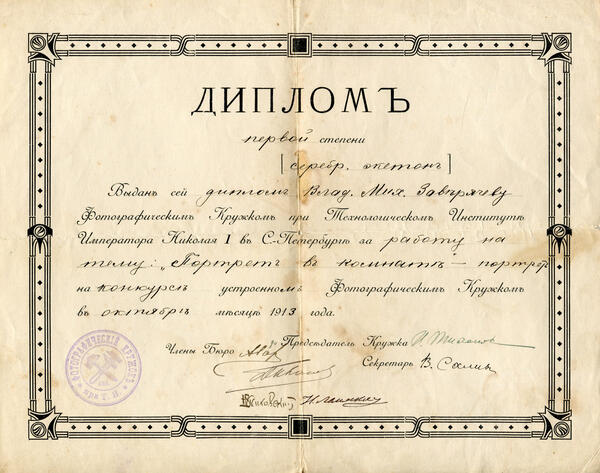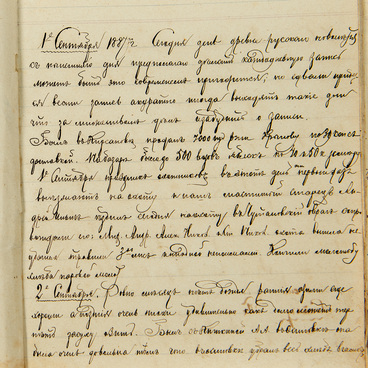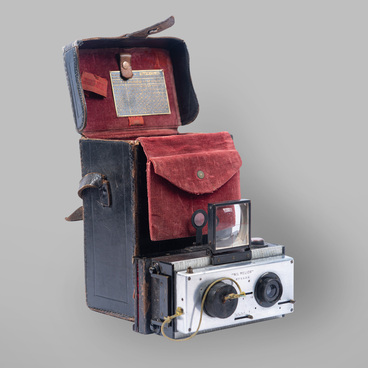The estates of the Boratynskys and Chicherins in Kirsanov District were home to a whole dynasty of managers — the Zaveryachevs. The ancestor of the dynasty, Andrey Nesterovich Zaveryachev, was valet to the Boratynskys at Ilyinovka. Noted by his lords for being literate, honest and efficient, he was later appointed the manager of the estate. Andrey Nesterovich had nine children. Two of his sons later became managers as well: Ivan Andreevich worked for the Chicherins in Karaul, Tambov Governorate, and Mikhail Andreevich — in Ilyinovka, after his father retired.
The brother of Andrey Nesterovich, Mikhail, also worked for the Boratynskys: he was a beekeeper in Ilyinovka. Mikhail Andreeevich had three sons: Vladimir, Sergey and Vasily. The eldest son Vladimir was an amateur photographer. While studying at the Technological Institute of Emperor Nicholas I in Saint Petersburg he was involved in the activities of the photographic society of that institute.
The Kirsanov Local History Museum houses awards of Vladimir Mikhailovich — diplomas for the competition organized by the photographic society in 1913. At the exhibition arranged by the photographic society in December 1913 the photographer was awarded the First Degree Diploma (silver badge) for his work entitled “Portrait in the Room — Portrait”, the Second Degree Diploma (large silver badge) for his color photograph (autochrome) “Dawn is Fading”. He also received commendation for his color photography works “Etude” and “Nature Morte” and his excellent skill of using the technique of autochrome process.
Vladimir Zaveryachev’s hobby was quite in the spirit of that age. Russia’s first contact with the art of photography occurred in 1839, after the Russian scientist Joseph Christian Hamel visited London to see the inventor William Talbot. Since then, photography in Russia gained popularity and was rapidly developing. At the turn of the 20th century, Russian photographers were full-fledged participants of international exhibitions and salons, as well as members of international photographic societies. At the same time, their works received the most prestigious prizes and awards.
The owner of the Ilyinovka estate, Mikhail Andreevich Boratynsky, was known to be passionate about photography too. He created a photo chronicle of his family. In 1912, he took part in an international photo exhibition, as evidenced by the archival documents and the catalog of his works.
The brother of Andrey Nesterovich, Mikhail, also worked for the Boratynskys: he was a beekeeper in Ilyinovka. Mikhail Andreeevich had three sons: Vladimir, Sergey and Vasily. The eldest son Vladimir was an amateur photographer. While studying at the Technological Institute of Emperor Nicholas I in Saint Petersburg he was involved in the activities of the photographic society of that institute.
The Kirsanov Local History Museum houses awards of Vladimir Mikhailovich — diplomas for the competition organized by the photographic society in 1913. At the exhibition arranged by the photographic society in December 1913 the photographer was awarded the First Degree Diploma (silver badge) for his work entitled “Portrait in the Room — Portrait”, the Second Degree Diploma (large silver badge) for his color photograph (autochrome) “Dawn is Fading”. He also received commendation for his color photography works “Etude” and “Nature Morte” and his excellent skill of using the technique of autochrome process.
Vladimir Zaveryachev’s hobby was quite in the spirit of that age. Russia’s first contact with the art of photography occurred in 1839, after the Russian scientist Joseph Christian Hamel visited London to see the inventor William Talbot. Since then, photography in Russia gained popularity and was rapidly developing. At the turn of the 20th century, Russian photographers were full-fledged participants of international exhibitions and salons, as well as members of international photographic societies. At the same time, their works received the most prestigious prizes and awards.
The owner of the Ilyinovka estate, Mikhail Andreevich Boratynsky, was known to be passionate about photography too. He created a photo chronicle of his family. In 1912, he took part in an international photo exhibition, as evidenced by the archival documents and the catalog of his works.



